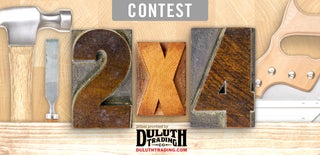Introduction: 2x4 Rustic Camera Frames
First I would like to give credit to thelastofthegentlemen for giving me the idea for this instructable. Thank you. Go ahead and check him out and see what he did.
My wife has a small collection of older/vintage cameras that she wanted to display and the frames I made seemed a good fit.
Step 1: Materials, Tools and Design
Materials:
-2x4's
-Wood glue
-Brad nails
-1/4-20x1/2 screws
-Epoxy
-Sawtooth hangers
-Adhesive backed felt pads
Tools:
-Miter saw
-Table saw
-Clamps
-Brad nailer
-Router w/chamfer bit
-Orbital Sander
-Screw driver
-Hammer
-Drill w/ 1/2 drill bit
When determining the dimensions for the frames I choose to have all the frames the same size regardless of the size of the camera. After playing around with spacing I choose to go with an inside dimension of 8"x7". You can really go with anything that will fit your style and desire.
Step 2: Cutting and Assembly
The frame itself is fairly easy to cut and assemble. I used a rabbet joint for all the frames, but any joint you come up with will work. The rabbet was cut into the top and bottom pieces. I used the miter saw to cut everything to length and used the table saw to cut the rabbet. I did not use a dado saw blade to cut these rabbets but I would highly suggest using one to made the process go by quicker. I simply set the height of the blade for the depth of the rabbet and set the fence to the width of the rabbet and moved each cut over the width of the blade until all the material was removed.
Glue up went quick. Spread plenty of wood glue inside all four rabbets and assemble the four sides. Use clamps to hold things in place while you go back with a brad nailer and nail all four corners going up from under the rabbet into the side pieces. Give the glue 24 hours to dry before putting any kind of stress on the joints.
Step 3: Adding a Little Detail and Stain
When the glue has finished fully drying, sand the joints smooth getting off any glue that squeezed out. I also went and sanded off any markings/lettering on the 2x4 that came from the mill. I did not worry about getting all surfaces extremely smooth. I wanted the frames to have an aged look. To add a little detail, take a chamfer bit in a router over all the exposed edges and lightly sand off any hard edges.
To stay with the aged look I used the same idea from thelastofthegentlemen and used coffee grounds to stain the wood. This was the first time using this technique so I wasn't sure the best application. I boiled some water and added a small amount to a bowl of coffee grounds to give a dark mixture. I did not bother to strain out the grounds but decided the grounds would add a subtle affect to the surface. I applied the stain using a brush adding more water to the grounds as needed. Do not be shy loading the surface up. After everything is dry you can brush off the loose grounds and reuse them for additional coats. The darker the stain the more coats you will apply.
At this point you also have the option of adding a clear coat to seal everything in.
Step 4: Securing the Cameras
To secure the cameras from falling off the frames I added a screw set into the bottom of the frame. First locate where the screw needs to be according to the location of the cameras mount. Drill a hole deep enough for the screw to sit in without it protruding too high for the cameras thread depth. This step would best be done before glue up but I did not think to add this feature until after I glued up.
To ensure that the the camera sits tight against the frame in the correct direction, thread the 1/4-20x1/2 screw into the cameras mount until it bottoms out and then back it off a quarter turn. Place a small amount of epoxy in the bottom of the hole and place the screw, still attached to the camera, into the hole and position the camera in the desired position. Do not put too much epoxy in the hole, otherwise it can squeeze out the top and glue the camera to the frame. After the epoxy has dried carefully unthread the camera from the screw making sure not to break the bond between the epoxy and the screw. Finish bonding the screw to the frame by filling in the rest of the hole with more epoxy. Make sure to protect the screw's threads from the epoxy with some tape.
Step 5: Hanging on the Wall
You can use any method of hanging you would like but I used the sawtooth hangers. They are easy to install on the back just make sure that they are nice and center. I also added a felt pad to the bottom corners to keep the frame parallel to the wall because of the hanger.
With the location of the wall mounts in, thread the the cameras on before hanging them up. One thing I did not plan for was the space needed to rotate the cameras onto the screws. The only camera I had a problem with was the nikon but I got lucky and was able to remove the lens that was hitting the side of the frame as I turned it.
My wife has a few more cameras that I plan on making a frame for and will post pictures of those in an update.
Thank you for your interest. If it is worth I would appreciate a vote in the 2x4 contest.

Participated in the
Homemade Gifts Contest 2015

Participated in the
2x4 Contest













